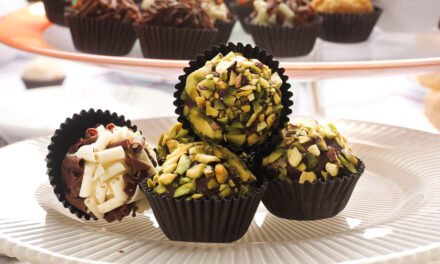
Recipes from the Arabian Gulf
Cardamom. It’s pungent, truculent and sweet. It’s been used for centuries in Indian spice blends, Scandinavian sweets and in Middle Eastern recipes and sometimes used to flavor coffee. The pre-oil days of al-Khaleej, the collective cluster of Bahrain, Kuwait, Oman, Qatar, Saudi Arabia and the United Arab Emirates along the Arabian Gulf, where different tribes roamed the desert and coasts searching for food (and trading recipes) are long gone. They’ve been replaced by an era of man-made islands and litter from fast food restaurants.
Two things remain, steadfast and resolute: the value of cardamom and the sharing of food throughout the region.
The food of al-Khaleej flourished as the trade winds from Africa and India brought dhows, the traditional Arabian sailing vessels, into ports along the Gulf, bringing riches in pearls, silver and spices. Ah yes, immigrant spices were a true treasure, bringing life to main dishes and accompaniments. Saffron threads, cumin seeds, chili, curry powder, turmeric and cardamom pods worked together to create incredible tastes and branded the Gulf with a distinctive flavor.
“It [the food of the Gulf] is a means of communication and social maker, a peace offering, a way of demonstrating largesse and hospitality to friends and family, a form of one-upmanship, a conversation starter, a boredom buster and an arena for female competitiveness. Recipes are coveted and secretly exchanged,” says Sarah al-Hamad, author of “Cardamom and Lime: Recipes from the Arabian Gulf,” from which these recipes are taken.
The enticing book contains a wealth of tantalizing dishes, each chronicled by al-Hamad with photographs as they were being prepared in their native lands and compiled to neatly introduce the culinary history of traditions in the coastal region, renowned more for black gold than culinary gold.
The Gulf, however, doesn’t have the market cornered on these delicious dishes. Cardamom spices up bills of fare throughout the United States as well: cooks play with the multipurpose pod to flavor everything from burgers to venison to Arabic coffee. Before eating out (see sidebar), try al-Hamad’s take on these delicious rice and chicken dishes enhanced by staple spices of the Middle East.
Tackling Cardamom

Muhammar (Date-Sweetend Rice)

“The most important regional food—and my great weakness—is the date. Its value as a cultural player transcends its culinary worth.”—al-Hamad
For energy, pearl divers traditionally ate rice sweetened with dibs (date-syrup) to accompany the fish they caught on those endless, arduous sea voyages on the dhows. Dibs was used as an alternative to sugar. These days, Muhammar is still served as an accompaniment to fish dishes, but on festive occasions it may be served with a roast leg of lamb. This is seriously sweet rice, contrasting perfectly with fish, and just how the locals like it. Honey is a good substitute for the dibs.
- 14 ounces basmati rice
- Pinch of saffron strands
- 1 ½ cups date syrup (dibs)
- 1 cinnamon stick
- 2 cardamom pods
- 1 tablespoon rosewater
- 14 ounces basmati rice
- Pinch of saffron strands
- 1 ½ cups date syrup (dibs)
- 1 cinnamon stick
- 2 cardamom pods
- 1 tablespoon rosewater
Biryani diyay (Chicken Biryani)

- Pinch of saffron strands
- 1 ½ pound chicken, cut into 6–8 pieces
- 1 large potato, sliced into thick rounds
- 3 teaspoons Madras curry powder
- Salt to taste
- 1 ½ cups vegetable oil
- 3 onions, finely chopped
- 2 ¾ ounces cashew nuts
- 2 ¾ ounces raisins
- 1 ½ garlic cloves, chopped
- ½ tablespoon ginger root, chopped
- ½ green chili, seeded and finely chopped
- 2 medium tomatoes, roughly chopped
- 1 teaspoon cilantro, chopped
- 7 ounces plain yogurt
- 1 tablespoon rosewater
For the rice:
- 11 ounces basmati rice
- 1 cinnamon stick
- 3 cloves
- 3 cardamom pods
- Salt to taste
- Pinch of saffron strands
- 1 ½ pound chicken, cut into 6–8 pieces
- 1 large potato, sliced into thick rounds
- 3 teaspoons Madras curry powder
- Salt to taste
- 1 ½ cups vegetable oil
- 3 onions, finely chopped
- 2 ¾ ounces cashew nuts
- 2 ¾ ounces raisins
- 1 ½ garlic cloves, chopped
- ½ tablespoon ginger root, chopped
- ½ green chili, seeded and finely chopped
- 2 medium tomatoes, roughly chopped
- 1 teaspoon cilantro, chopped
- 7 ounces plain yogurt
- 1 tablespoon rosewater
For the rice:
- 11 ounces basmati rice
- 1 cinnamon stick
- 3 cloves
- 3 cardamom pods
- Salt to taste
Editor’s Note:
Serve with a side of yogurt and chopped cucumbers.
Diyay mahshi bil tamr (Chicken with Date, Prune, and Nut Stuffing)

- 1 whole chicken
For the marinade:
- 2 tablespoons barbecue sauce
- ½ teaspoon turmeric
- 1 teaspoon salt
For the stuffing:
- 3 tablespoons walnuts
- 2 tablespoons almonds
- 3 tablespoons pine nuts
- 2 tablespoons vegetable oil
- 1 small onion, finely chopped
- 1 tomato, finely chopped
- 1 ½ teaspoons barbecue sauce
- 2 tablespoons lemon juice
- 9 ounces prunes, roughly chopped
- 9 ounces dates, roughly chopped
- 3 tablespoons cooked rice (any type)
- Salt to taste
- 1 whole chicken
For the marinade:
- 2 tablespoons barbecue sauce
- ½ teaspoon turmeric
- 1 teaspoon salt
For the stuffing:
- 3 tablespoons walnuts
- 2 tablespoons almonds
- 3 tablespoons pine nuts
- 2 tablespoons vegetable oil
- 1 small onion, finely chopped
- 1 tomato, finely chopped
- 1 ½ teaspoons barbecue sauce
- 2 tablespoons lemon juice
- 9 ounces prunes, roughly chopped
- 9 ounces dates, roughly chopped
- 3 tablespoons cooked rice (any type)
- Salt to taste
Editor’s Note:
The nuttiness and sweetness of this dish make brown rice the perfect accompaniment.
Muhalbiyat al-ruz (Milky rice pudding)

- 6 ounces basmati rice
- 4 cups whole milk
- 6–8 tablespoons sugar
- ½ teaspoon green cardamom seeds, crushed
- 3 tablespoons rosewater
- Handful pistachios, chopped
- 6 ounces basmati rice
- 4 cups whole milk
- 6–8 tablespoons sugar
- ½ teaspoon green cardamom seeds, crushed
- 3 tablespoons rosewater
- Handful pistachios, chopped
Editor’s Note:
Serve sprinkled with chopped pistachios.
It’s Nearer Than You Think
Cardamom Ice Cream?

Want to Make It? All You Need Is an Ice Cream Machine and These Ingredients:
- 1 cup heavy whipping cream
- 2 cups half & half
- 1 tablespoon honey
- ½ cup brown sugar
- ½ cup sugar
- 1 ½ teaspoons cardamom
- 1 ½ teaspoons cinnamon
- 1 ¼ teaspoons vanilla extract
- 2 teaspoons lemon juice
- 1 pinch salt
- 1 cup heavy whipping cream
- 2 cups half & half
- 1 tablespoon honey
- ½ cup brown sugar
- ½ cup sugar
- 1 ½ teaspoons cardamom
- 1 ½ teaspoons cinnamon
- 1 ¼ teaspoons vanilla extract
- 2 teaspoons lemon juice
- 1 pinch salt
Quince
Baltimore’s Wine Market features an exquisite three-cheese plate with quince paste and cardamom-spiced almonds; the casual restaurant reports it is inexplicably their most popular menu item.
921 E. Fort Ave. # 135, Baltimore, MD 21230;
(410) 244-6166.
Lamb Burgers
The secret spice in the lamb burgers at Salt Lake City’s Acme Burger is a half teaspoon of black cardamom in each of his six-ounce patties. Says chef Adam Kreisel, “It’s earthy, toasty and a tiny bit peppery, and it sells splendidly.”
275 S 200 W, Salt Lake City, UT 84101.
(801) 257-5700.
Bliss Cakes
Lines form long on Sundays at San Diego’s Cardamom Cafe & Bakery, many to dig into the Bliss Cakes. Part pancake, part crepe, they are delectable and creamy with cardamom intermingled with honey and vanilla. Perfect for those mornings when you just have to try something new.
2977 Upas St., San Diego, CA 92104;
(619) 546-5609.
Arabic Coffee
A throwback to the first Middle Eastern coffee blends (circa 1500), try the Coffee Cairo (1 lb. bag, $15) from Natasha’s cafe The coffee is spiced with cardamom and cloves and is just like you’ll find at the high end hotels across the Gulf.

























